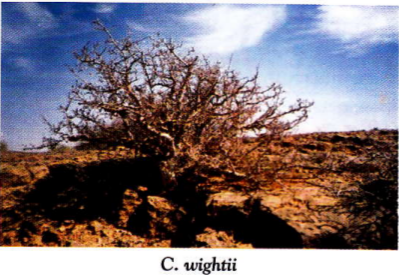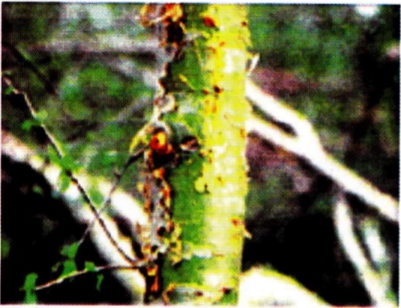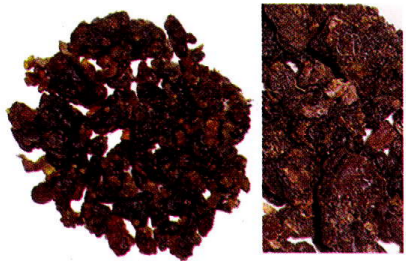Guggul
Guggul
Guggul or Indian Myrrh is the yellowish gum-resin produced by the stem of the guggul tree (Commiphora spp.)
Local names : Bengali, Gujarati - Guggul, Hindi – Guggulu, Guggal; Kannada - Guggal; Marathi - Guggala; Malayalam - Gulgulu, Guggalu; Tamil – Maishakshi, Gukkal; Telugu – Guggal
Plant Sources : Commiphora mukul and Commiphora wightii (Arn.)
Family : Burseraceae
Distribution: Guggal is a spiny shrub or small tree with many branches, usually growing two or three meters high, that is native to India, Arabia and Pakistan. It is found in the arid, rocky tracts of Rajasthan, Gujarat, Madhya Pradesh and Karnataka in India. The Commiphora mukul tree has an ash-colored bark that comes off in large rough flakes, exposing the under bark that also peels away. The tree remains without any foliage for most of the year.
The plant prefers arid and semi-arid climates and is tolerant of poor soil. It grows well in sandy to silt loam soils, which are poor in organic matter and rich in other matters and also considered as drought and salinity resistant plant.The plant has a wide adaptability and if found growing in arid regions under varying conditions.
Major producing countries:India, Pakistan and UAE.
Harvesting/Collection of Gum Resin
Method of harvesting/tapping : The gum resin resides in the ducts located in the soft bark of the tree. It is obtained through a process called tapping. After attaining complete maturity of plant, it is tapped from main stem. The resin ducts occur in the bark portion near cambial layer.


Plant attaining 7.5 cm diameter is suitable for tapping. Usually 1.5 cm deep circular incisions are made on the main stem, not beyond the thickness of the bark. Guggul oozes out from these incisions as a pale yellow, aromatic fluid that quickly solidifies to form a golden brown or reddish brown agglomerate of tears or stalactic pieces. It is collected manually or with spear. The gum-resin is scraped off the wound with the knife. The collection is done at an interval of 10-15 days.
Period of harvesting/collection : The trees are tapped for resin from November through January, and collection continues until May or June through a nick on the bark of the tree.
Yield : A healthy tree yields 250-500 grams of gum-resin in one season, and guggal plants typically begin yielding resin after five years. Starting from the sixth year, yield of gum resin increases from 200 to 400gm per plant.
Processing and Value Addition
The exuded resin is allowed to dry on the tree before it is collected. Collected resin is cleaned by sieving and hand picking to remove foreign matter, and packed in sacks for transfer to points of sale, either nationally or internationally. The collected gum is graded according to its purity.
Extracts of the gum-resin include compounds known for their hypolipidemic properties, the Z-and E-isomers of guggulsterone and its related guggulsterols: guggulsterol I, guggulsterol-II, guggulsterol-III, guggulsterol IV, guggulsterol V and guggulsterol VI. A standardized extract of the guggulsterones.
Properties
- The dried gum-resin has a bitter aromatic taste and balsamic odour
- The colour of guggul varies from transparent golden brown to dark brown.
- It is soluble in most organic solvents.
- It burns readily and diffuses an pleasant odour.
Industrial Applications
Traditional Uses : Gum guggul is used as incense, to make lacquers, varnishes, and ointments, as a fixative in perfumes, and in medicine.
Gum guggul has been used to treat dysmenorrhea, dyspepsia, endometritis, hypercholesteremia, hypertension, impotence, bronchitis, caries, catarrh, gingivitis, hay fever, hysteria, inflammation, laryngitis, lochia, mania, pharyngitis, phthisis, sores, sore throat, stimulant, tonsillitis, tumors, wounds bone fractures, gout, scrofula, sciatica, facial paralysis, diplegia, leprosy, leucoderma, pectoral disorders, otorrhea, epilepsy, fever, strangury, hemorrhoids, dysmenorrheal, amenorrhea, ulcers, anemia, coronary, thrombosis, stomatopathy, pharyngopathy, spermatorrhea, urinary calculus, diabetes, trichosis, to enhance phagocytosis, to increase leukocytes, to induce abortion, and as a tonic for the uterus.
Modern Uses : Modern therapeutic uses of guggul include nervous diseases, hemiplegia, leprosy, marasmus, musclespasms, neuralgia, ophthalmia, pyelitis, pyorrhea, scrofula, skin disorders, spongy gums, ulcerative pharyngitis, hypertension, ischemia,hypertension, and urinary disorders. The Ayurvedic herb Inula racemosa, in combination with C. mukul, is used to reduce chest pain and dyspnea of angina.
Research studies showed that guggul is effective against aspects of cardiovascular disease. Guggul reduced the stickiness of platelets, and Gugulipid was shown to be an efficacious and cost effective treatment of hyperlipoproteinemia.
Last Modified : 3/1/2020
This topic provides information about Rosin, a sol...
This topic provides information about Asafoetida.
This topic provides information about Gum karaya, ...
This topic provides information about Guar gum.
